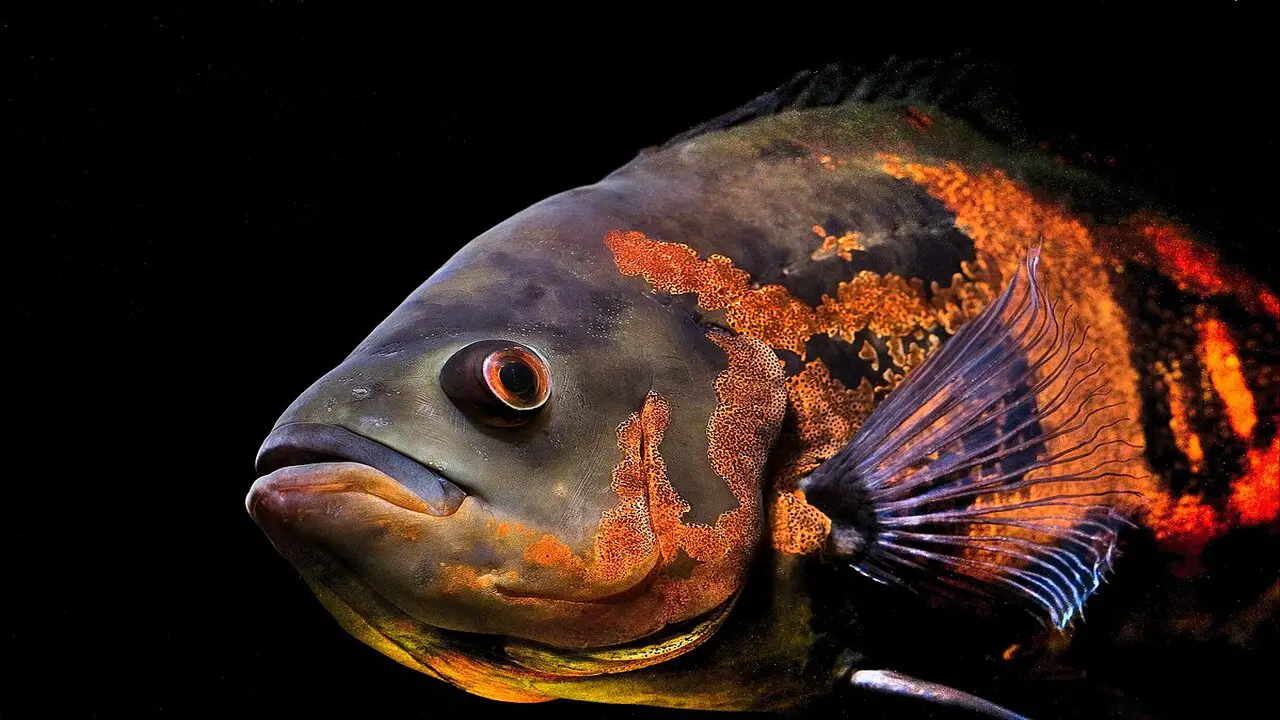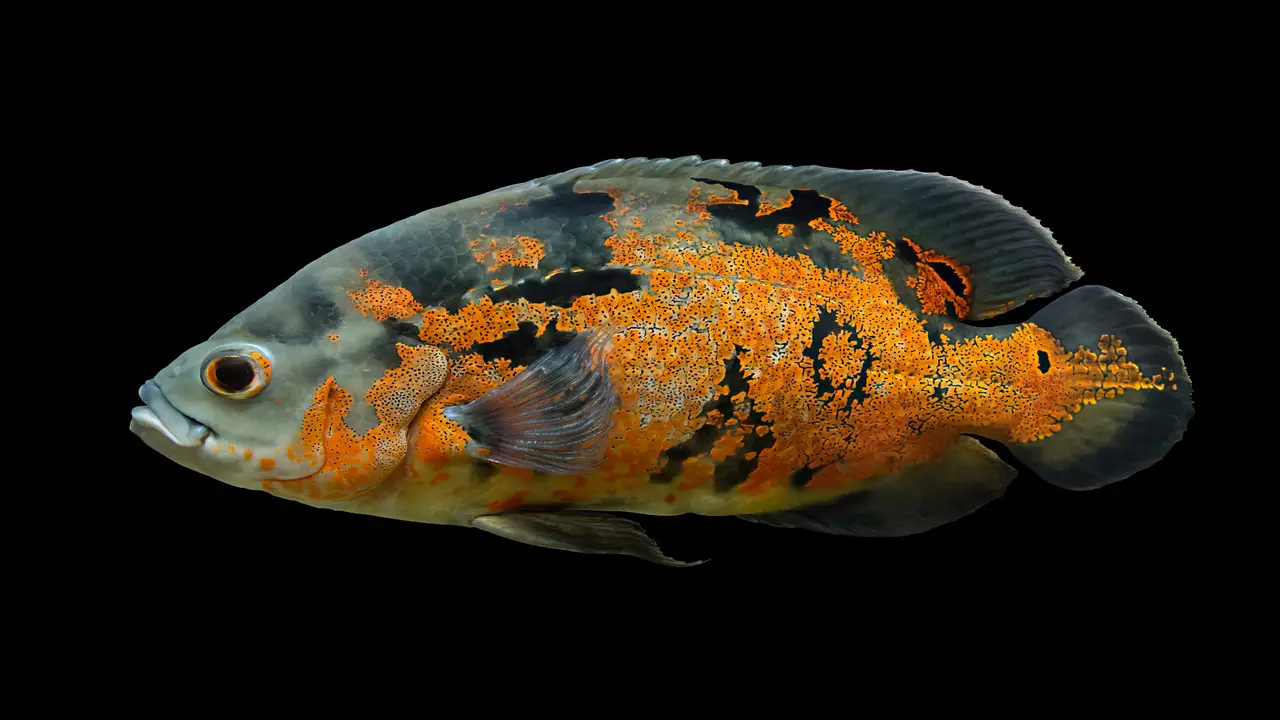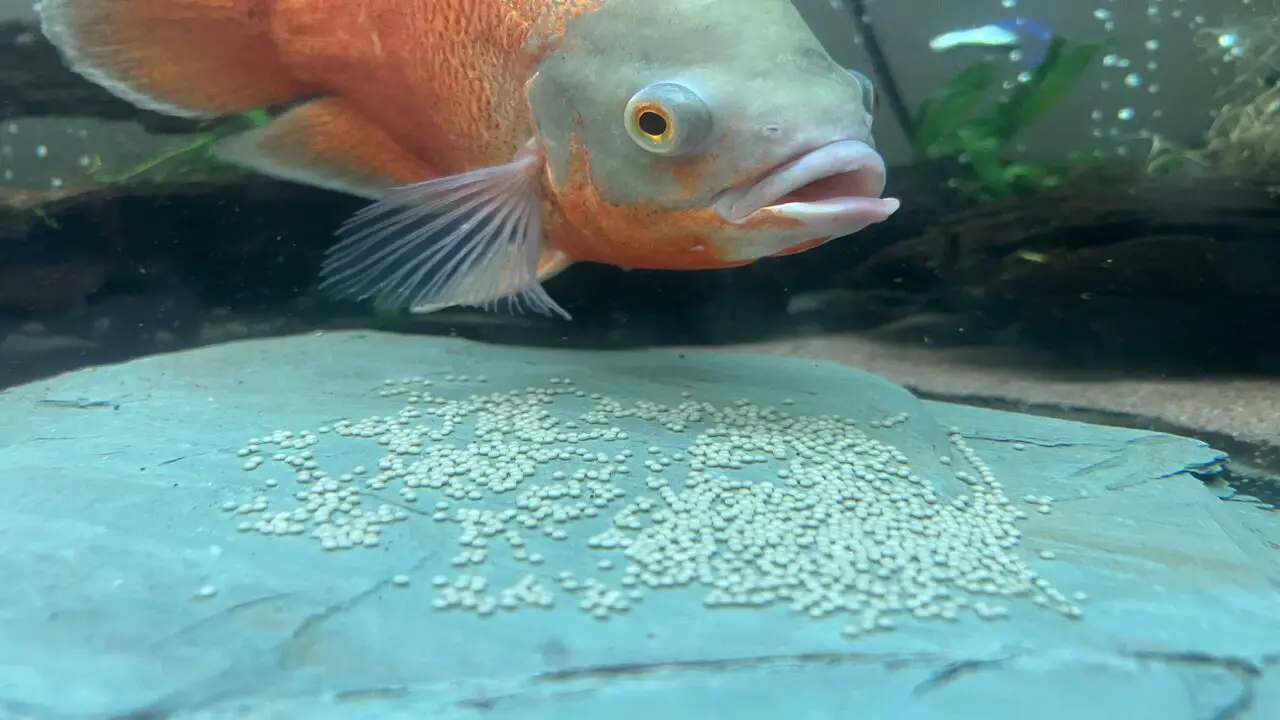Breeding Oscar fish can be a thrilling and rewarding experience for any aquarium hobbyist. However, it requires patience, knowledge, and the right environment to ensure successful egg fertilization.
Understanding their breeding habits is crucial to creating an optimal environment that promotes healthy egg fertilization. Here, we will look in-depth at Oscar fish and their breeding habits, including recognizing when they are ready to breed, preparing the breeding tank for optimal conditions, and caring for the eggs until hatching occurs. So, if you’re ready to start breeding your Oscar fish successfully, keep reading.

About Oscar Fish
Oscar fish, also known as Astronotus ocellatus, is a popular freshwater fish among aquarium enthusiasts. These colorful and intelligent fish are native to South America and are known for their distinctive appearance and unique behavior. Oscar fish can grow quite large, reaching lengths of up to 12 inches or more.
They have a variety of color variations, including red, albino, and tiger patterns. In addition to their striking appearance, Oscar fish are known for their aggressive nature and territorial behavior. Providing them with a spacious tank and plenty of hiding places is essential to help minimize aggression.
Characteristics Of Oscar-Fish

- Oscar fish, also known as Astronotus ocellatus, are freshwater fish native to South America.
- They have a distinctive oval-shaped body with a large head and a mouth that can be quite wide.
- Oscar fish come in various colour variations, including orange, red, yellow, and black shades.
- These fish can grow quite large, reaching up to 12-14 inches in captivity.
- They are known for their intelligence and can be trained to recognize their owners and perform simple tricks.
- Oscar fish are territorial by nature and require a spacious aquarium with plenty of hiding spots and territories for each fish.
- They are omnivorous and have a hearty appetite, requiring a varied diet of live and frozen foods and high-quality pellets.
- Oscar fish are generally peaceful towards larger tankmates but can become aggressive towards smaller or slower-moving fish.
Oscar Fish Eggs Hatching: What To Expect

Oscar-fish eggs, also known as caviar, are a delicacy many seafood enthusiasts enjoy. These small, round eggs come in various colors, from pale yellow to dark brown, and have a rich, buttery flavor.
Harvesting oscar-fish eggs requires careful handling to ensure their quality and freshness. Once harvested, they can be used in various dishes, such as sushi or pasta toppings, or enjoyed independently. Oscar fish eggs are a luxurious treat that adds a touch of elegance to any meal.
- The eggs are typically laid on a flat surface, such as a rock or the aquarium, and are guarded by the parents until they hatch.
- Once the eggs hatch, you can expect to see tiny fry swimming around. Providing them with a suitable environment and proper nutrition is important to ensure their survival and healthy growth.
- After the female Oscar fish lays her eggs, the male fertilizes them and guards the nest.
- The eggs typically take 2-3 days to hatch depending on water temperature and conditions.
- Once hatched, the fry will remain attached to the nest for several more days until they are ready to swim freely.
- During this time, providing a suitable environment with clean water and plenty of hiding places for the fry to grow and develop is crucial.
- They will still rely on their yolk sacs for nourishment, so it is important to provide them with a suitable environment and proper nutrition as they grow.
How To Incubate Oscar-Fish Eggs
Incubating Oscar-fish eggs can be an exciting and rewarding experience for fish enthusiasts. To successfully incubate Oscar-fish eggs, you must create the optimal conditions for the eggs to hatch and develop. Here are some steps to follow:
- Prepare a separate tank: Transfer the eggs into a separate tank filled with clean, filtered water. Ensure the tank has appropriate filtration and aeration to maintain water quality and oxygen levels.
- Adjust water parameters: Maintain a temperature of around 78-82°F (25-28°C) and pH level between 6.5-7.5 in the incubation tank. These conditions mimic their natural habitat and promote healthy egg development.
- Provide a suitable substrate: Place fine-grained substrate, such as sand or marbles, at the bottom of the tank. This will prevent the eggs from getting damaged or eaten by other fish.
- Protect the eggs: Install an egg guard or use a mesh netting to protect the eggs from being consumed by adult fish or other tank inhabitants.
- Ensure proper lighting: Use low-intensity lighting in the incubation tank to mimic natural lighting conditions and prevent stress on the developing embryos.
Feeding Oscar Fish Fry After Hatching
Feeding Oscar fish fry after hatching is a crucial step in their development. Once the eggs have hatched and the fry is free-swimming, they must have proper nutrition to ensure their growth and survival. Initially, the fry can be fed infusoria or finely crushed flakes to accommodate their small size.
As they grow, their diet can gradually transition to baby brine shrimp or crushed pellets designed for young fish. Feeding the fry multiple times daily in small amounts is important to prevent overfeeding and maintain water quality.
How To Care For Oscar Fish Eggs

Caring for Oscar-fish eggs requires careful attention and proper maintenance to ensure their successful hatching and development. Here are some tips to help you care for Oscar-fish eggs:
- Separate the parents: Once the Oscar fish have laid their eggs, separating them from other tank mates is important. This will help prevent potential aggression or disturbances that may harm the eggs.
- Provide a suitable environment: Create a separate breeding tank that mimics the natural conditions of the Oscar fish’s habitat. The water temperature should be between 78-82°F (25-28°C), and the pH level should be around 6.5-7.5.
- Maintain water quality: Regularly monitor and maintain water quality by performing regular water changes and using a reliable filtration system. Keeping the water clean and free from any pollutants or toxins is crucial.
- Protect the eggs: Place a spawning mop or fine mesh net in the breeding tank to provide a safe place for the female Oscar fish to deposit her eggs. This will protect the eggs from being consumed by other fish or damaged.
- Ensure proper oxygenation: Install an air stone or provide gentle water movement in the breeding tank to ensure adequate oxygenation for the eggs and fry once they hatch.
- Monitor egg development: Keep a close eye on the eggs and regularly check for any signs of fungus or discoloration, as these could indicate potential issues with egg viability.
- Feed appropriately: As the eggs start to hatch, you can begin feeding them infusoria or specialized fry food designed for small fish. Gradually transition them to larger food options as they grow.
Benefits Of Breeding Oscar Fish
Breeding Oscar fish can have several benefits for fish enthusiasts. One of the main advantages is the ability to witness the fascinating process of fish reproduction and raise a new generation of fish in your aquarium. Breeding Oscars can also be financially rewarding, as you can sell or trade the offspring to other fish keepers or pet stores.
Additionally, breeding Oscars allows you to preserve and propagate specific genetic lines or color variations that you find particularly appealing. By carefully selecting and pairing compatible Oscars, you can create unique and beautiful strains of these popular aquarium fish.
Common Problems Encountered When Hatching Oscar-Fish Eggs

Hatching Oscar-fish eggs can be a rewarding experience, but it’s not without challenges. By being aware of these common problems and taking steps to prevent them, you can increase your chances of successfully hatching Oscar-fish eggs and enjoying the sight of tiny fry swimming in your tank. Here are some common problems that you may encounter when trying to hatch Oscar- -fish eggs:
- Fungus: Fungus can develop on the eggs if they are not kept in clean water or poor water quality. This can lead to the eggs becoming infected and ultimately not hatching.
- Infertile eggs: Not all eggs will be fertile, and it’s normal for a certain percentage not to hatch. However, if many eggs are not hatching, it could indicate a problem with the breeding pair or their environment.
- Poor water conditions: Oscar-fish eggs require clean and stable water conditions to hatch successfully. If the water parameters are off, such as high ammonia or nitrite levels, it can negatively impact the development of the embryos.
- Predators: Other fish or parents may see the eggs as a tasty snack and eat them before hatching. It’s important to provide a separate breeding tank or use dividers to protect the eggs from potential predators.
- Temperature fluctuations: Oscars are sensitive to temperature changes, and extreme fluctuations can hinder the development of the embryos. It’s crucial to maintain a stable temperature throughout the incubation period.
How To Prevent Fungus On Oscar-Fish Eggs
Preventing fungus on Oscar-fish eggs is crucial for their successful hatching and survival. By following these tips, you can greatly reduce the risk of fungus developing on your Oscar-fish eggs and increase the chances of successful hatching. Here are some tips to help you prevent fungus from developing on the eggs:
- Maintain clean water conditions: Regularly test and monitor the water parameters in your aquarium, including temperature, pH levels, and ammonia levels. Clean the tank regularly to remove any debris or waste that could contribute to poor water quality.
- Provide adequate aeration and filtration: Ensure your aquarium has proper aeration and filtration systems to maintain optimal oxygen levels and water circulation. This can help prevent stagnant water conditions that may promote fungal growth.
- Remove any unfertilized eggs: Fungus spreads quickly, so removing any unfertilized eggs from the tank can help prevent the spread of fungal spores to healthy eggs.
- Use antifungal treatments if necessary: If you notice signs of fungus on the eggs, such as white cotton-like growths, consider using an antifungal treatment specifically designed for fish eggs. Follow the instructions carefully and monitor the progress closely.
The Difference Between Fertile And Infertile Oscar-Fish Eggs

There is a clear distinction between fertile and infertile eggs when Oscar-fish eggs. Fertile eggs are those that a male Oscar fish has successfully fertilized. These eggs will typically appear opaque or slightly translucent, with a small dot or “eye” visible inside the egg.
In contrast, infertile eggs are unfertilized and will remain clear or white. It’s important to note that infertile eggs will not hatch and should be removed from the tank to prevent them from decomposing and affecting water quality. Monitoring the condition of the eggs can provide valuable insights into the reproductive health of your Oscar fish pair.
Conclusion
Breeding Oscar fish eggs can be a rewarding and fascinating experience for enthusiasts. Understanding the breeding habits of these beautiful creatures is crucial for successfully fertilizing and hatching their eggs. It is important to create optimal conditions in a separate breeding tank and closely monitor the behavior of the male and female Oscars for signs of breeding readiness.
Proper water parameters must be maintained to ensure successful fertilization, and the eggs should be carefully cared for until hatching occurs. Not all breeding attempts will be successful, and sometimes, the eggs may turn white due to fungus. With patience, knowledge, and careful observation, you can enjoy the joy of raising a new generation of Oscar fish in your aquarium.
Frequently Asked Questions
Where Do Oscars Lay Their Eggs?
Oscars lay their eggs on a chosen flat surface like a rock or leaf. They prepare it by cleaning and rubbing their bodies on it. The female deposits the eggs while the male fertilizes them. Oscars are protective parents, guarding their laid eggs vigilantly.
How Long Does It Take For Oscar-Fish Eggs To Hatch?
Oscar-fish eggs typically take around 2-3 days to hatch. During this time, the male Oscar fish diligently fans the eggs to keep them oxygenated. Once hatched, the fry will attach themselves to surfaces using a sticky substance on their bodies. It is recommended to separate the fry from their parents and provide them with a diet of small, live foods.
What Do Oscar-Fish Eggs Look Like?
Oscar-fish eggs are small, round, and 1-2 millimeters in diameter. They can range in color from light yellow to orange or brown. These eggs are typically laid on flat surfaces like rocks or aquarium glass. The parents diligently guard and keep the eggs clean until they hatch within 2-3 days.
Why Are My Oscar-Fish Eggs Turning White?
White eggs in Oscar fish may indicate infertility or the development of fungus. Regularly check if the male fish fertilizes the eggs and remove unfertilized ones. Maintain good water quality and temperature to prevent fungus growth. Consider using a fungicide treatment for significant white egg occurrence.
How To Make Oscar Fish Mate In Captivity?
To make Oscar fish mate in captivity, ensure they are healthy and mature. Provide a suitable environment with clean water and hiding spots. Adjust water temperature, feed high-quality food, and provide optimal lighting conditions to stimulate breeding behavior. Be patient and observe signs of courtship, like chasing or dancing.

Aquarium passion is all about connecting with the aquatic life and providing education to the public on the importance of these creatures. We showcase a wide variety of marine life through our exhibits as well as working with schools to provide unique learning opportunities for students of all ages.





